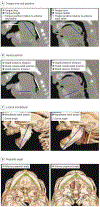Upper Airway Computed Tomography Measures and Receipt of Tracheotomy in Infants With Robin Sequence
- PMID: 27254152
- PMCID: PMC7279067
- DOI: 10.1001/jamaoto.2016.1010
Upper Airway Computed Tomography Measures and Receipt of Tracheotomy in Infants With Robin Sequence
Abstract
Importance: Airway management in infants with Robin sequence is challenging. Objective upper airway measures associated with severe airway compromise requiring tracheotomy are needed to guide decision making.
Objectives: To define objective upper airway measures in infants with Robin sequence from craniofacial computed tomography (CT) and to identify those measures in Robin sequence associated with tracheotomy.
Design, setting, and participants: A cohort study (2003 to 2014, over 1-year follow-up) of 37 infants with Robin sequence evaluated for surgical management and 37 selected age- and sex-matched controls without a craniofacial condition conducted in a pediatric institution's craniofacial center.
Main outcomes and measures: Define and compare CT-generated upper airway measures in these groups: infants with Robin sequence vs controls, and infants with Robin sequence with vs without tracheotomy. A negative difference signifies lower values for the Robin sequence and tracheotomy groups. Clinical data collected included age and height at time of CT scan, sex, tracheotomy presence, associated syndrome, and laboratory indicators of hypoventilation and hypoxemia. To evaluate interrater reliability, 2 raters performed each measurement in the Robin sequence group.
Results: In 74 infants, 17 of 28 measures were different between infants with Robin sequence and those in the control group. Tracheotomy was performed in 14 of 37 (38%) infants with Robin sequence. Infants with tracheotomy more commonly had associated syndromes (12 of 14 [86%] vs 11 of 23 [48%]) and a history of hypoventilation and hypoxemia (13 of 14 [93%] vs 15 of 23 [65%]). Five of the 11 measures associated with tracheotomy were reliable and simpler to measure with the following mean differences (95% CIs) between groups: tongue length, 0.87 (0.26 to 1.48); tongue position relative to palate, 0.83 (0.22 to 1.45); mandibular total length, -0.8 (-1.42 to -0.19); gonial angle, 0.71 (0.08 to 1.34); and inferior pogonial angle, 0.66 (0.02 to 1.29). Using a receiver operating characteristic analysis, a composite score of these 5 measures for predicting tracheotomy risk yielded an area under the curve of 0.83 and achieved 86% sensitivity and 74% specificity.
Conclusions and relevance: Computed tomography measures quantifying tongue position and mandibular configuration can identify infants with Robin sequence, and importantly, differentiate those who have severe upper airway compromise requiring tracheotomy. Following validation, these measures can be used for objective upper airway assessment and for expediting clinical decision-making in these challenging cases for which no such tools currently exist.
Conflict of interest statement
Figures



References
-
- Printzlau A, Andersen M. Pierre Robin sequence in Denmark: a retrospective population-based epidemiological study. Cleft Palate Craniofac J. 2004;41(1):47–52. - PubMed
-
- Bush PG, Williams AJ. Incidence of the Robin Anomalad (Pierre Robin syndrome). Br J Plast Surg. 1983;36(4):434–437. - PubMed
-
- Robin P Backward lowering of the root of the tongue causing respiratory disturbances. Bull Acad Med. 1923;89:37–41.
-
- Poets CF, Bacher M. Treatment of upper airway obstruction and feeding problems in Robin-like phenotype. J Pediatr. 2011;159(6):887–892. - PubMed
Publication types
MeSH terms
Grants and funding
LinkOut - more resources
Full Text Sources
Other Literature Sources
Medical

